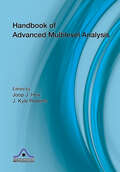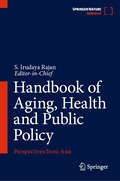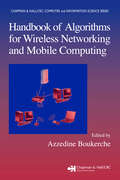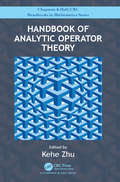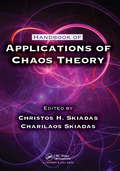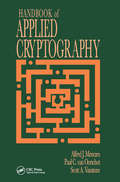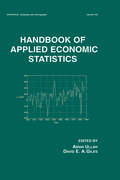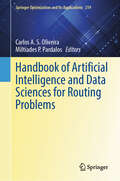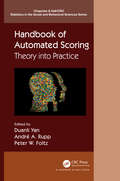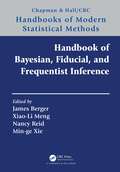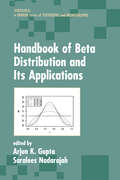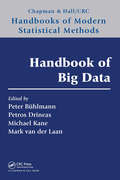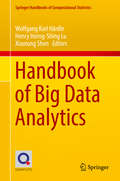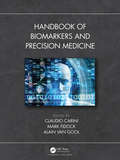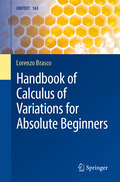- Table View
- List View
Handbook of Adaptive Designs in Pharmaceutical and Clinical Development
by Shein-Chung Chow Annpey PongIn response to the US FDA's Critical Path Initiative, innovative adaptive designs are being used more and more in clinical trials due to their flexibility and efficiency, especially during early phase development. Handbook of Adaptive Designs in Pharmaceutical and Clinical Development provides a comprehensive and unified presentation of the princip
Handbook of Advanced Multilevel Analysis (European Association of Methodology Series)
by Joop J. HoxThis new handbook is the definitive resource on advanced topics related to multilevel analysis. The editors assembled the top minds in the field to address the latest applications of multilevel modeling as well as the specific difficulties and methodological problems that are becoming more common as more complicated models are developed. Each chapter features examples that use actual datasets. These datasets, as well as the code to run the models, are available on the book’s website http://www.hlm-online.com . Each chapter includes an introduction that sets the stage for the material to come and a conclusion. Divided into five sections, the first provides a broad introduction to the field that serves as a framework for understanding the latter chapters. Part 2 focuses on multilevel latent variable modeling including item response theory and mixture modeling. Section 3 addresses models used for longitudinal data including growth curve and structural equation modeling. Special estimation problems are examined in section 4 including the difficulties involved in estimating survival analysis, Bayesian estimation, bootstrapping, multiple imputation, and complicated models, including generalized linear models, optimal design in multilevel models, and more. The book’s concluding section focuses on statistical design issues encountered when doing multilevel modeling including nested designs, analyzing cross-classified models, and dyadic data analysis. Intended for methodologists, statisticians, and researchers in a variety of fields including psychology, education, and the social and health sciences, this handbook also serves as an excellent text for graduate and PhD level courses in multilevel modeling. A basic knowledge of multilevel modeling is assumed.
Handbook of Aging, Health and Public Policy: Perspectives from Asia
by S. Irudaya RajanThis handbook presents the latest information on all aspects of global aging, with a focus on Asia, including policies, age-associated diseases and conditions, health services, long-term care, living arrangements, income and social security, preventing abuse, and the impact of migration on the elderly. Furthermore, the book presents a synthesis of research on population aging, social protection policies, crimes against the elderly, new analyses of trends, and discussions of major social policy strategies. Written by academics, practitioners and policymakers in the field of gerontology, the book offers an informative resource for demographers, gerontologists, economists, anthropologists and other social scientists studying various facets of aging, as well as students in the social and health sciences.
Handbook of Algorithms for Wireless Networking and Mobile Computing (Chapman & Hall/CRC Computer and Information Science Series)
by Azzedine BoukercheThe Handbook of Algorithms for Wireless Networking and Mobile Computing focuses on several aspects of mobile computing, particularly algorithmic methods and distributed computing with mobile communications capability. It provides the topics that are crucial for building the foundation for the design and construction of future generations of mobile and wireless networks, including cellular, wireless ad hoc, sensor, and ubiquitous networks. Following an analysis of fundamental algorithms and protocols, the book offers a basic overview of wireless technologies and networks. Other topics include issues related to mobility, aspects of QoS provisioning in wireless networks, future applications, and much more.
Handbook of Alternative Data in Finance, Volume I (CRC Press/OptiRisk Series in Finance)
by Gautam Mitra Christina Erlwein-Sayer Kieu Thi Hoang Diana Roman Zryan SadikHandbook of Alternative Data in Finance, Volume I motivates and challenges the reader to explore and apply Alternative Data in finance. The book provides a robust and in-depth overview of Alternative Data, including its definition, characteristics, difference from conventional data, categories of Alternative Data, Alternative Data providers, and more. The book also offers a rigorous and detailed exploration of process, application and delivery that should be practically useful to researchers and practitioners alike. Features Includes cutting edge applications in machine learning, fintech, and more Suitable for professional quantitative analysts, and as a resource for postgraduates and researchers in financial mathematics Features chapters from many leading researchers and practitioners
Handbook of Analytic Computational Methods in Applied Mathematics
by George AnastassiouWorking computationally in applied mathematics is the very essence of dealing with real-world problems in science and engineering. Approximation theory-on the borderline between pure and applied mathematics- has always supplied some of the most innovative ideas, computational methods, and original approaches to many types of problems. The f
Handbook of Analytic Operator Theory (CRC Press/Chapman and Hall Handbooks in Mathematics Series)
by Kehe ZhuHandbook of Analytic Operator Theory thoroughly covers the subject of holomorphic function spaces and operators acting on them. The spaces covered include Bergman spaces, Hardy spaces, Fock spaces and the Drury-Averson space. Operators discussed in the book include Toeplitz operators, Hankel operators, composition operators, and Cowen-Douglas class operators. <P><P>The volume consists of eleven articles in the general area of analytic function spaces and operators on them. Each contributor focuses on one particular topic, for example, operator theory on the Drury-Aversson space, and presents the material in the form of a survey paper which contains all the major results in the area and includes all relevant references. The overalp between this volume and existing books in the area is minimal. The material on two-variable weighted shifts by Curto, the Drury-Averson space by Fang and Xia, the Cowen-Douglas class by Misra, and operator theory on the bi-disk by Yang has never appeared in book form before. <P><P>Features: <li>The editor of the handbook is a widely known and published researcher on this topic <li>The handbook's contributors are a who's=who of top researchers in the area <li>The first contributed volume on these diverse topics
Handbook of Applications of Chaos Theory
by CHRISTOS H. SKIADAS AND CHARILAOS SKIADASIn addition to explaining and modeling unexplored phenomena in nature and society, chaos uses vital parts of nonlinear dynamical systems theory and established chaotic theory to open new frontiers and fields of study. Handbook of Applications of Chaos Theory covers the main parts of chaos theory along with various applications to diverse areas. Expert contributors from around the world show how chaos theory is used to model unexplored cases and stimulate new applications. Accessible to scientists, engineers, and practitioners in a variety of fields, the book discusses the intermittency route to chaos, evolutionary dynamics and deterministic chaos, and the transition to phase synchronization chaos. It presents important contributions on strange attractors, self-exciting and hidden attractors, stability theory, Lyapunov exponents, and chaotic analysis. It explores the state of the art of chaos in plasma physics, plasma harmonics, and overtone coupling. It also describes flows and turbulence, chaotic interference versus decoherence, and an application of microwave networks to the simulation of quantum graphs. The book proceeds to give a detailed presentation of the chaotic, rogue, and noisy optical dissipative solitons; parhelic-like circle and chaotic light scattering; and interesting forms of the hyperbolic prism, the Poincaré disc, and foams. It also covers numerous application areas, from the analysis of blood pressure data and clinical digital pathology to chaotic pattern recognition to economics to musical arts and research.
Handbook of Applied Cryptography (Discrete Mathematics and Its Applications)
by Paul C. van Oorschot Alfred J. Menezes Scott A. VanstoneCryptography, in particular public-key cryptography, has emerged in the last 20 years as an important discipline that is not only the subject of an enormous amount of research, but provides the foundation for information security in many applications. Standards are emerging to meet the demands for cryptographic protection in most areas of data communications. Public-key cryptographic techniques are now in widespread use, especially in the financial services industry, in the public sector, and by individuals for their personal privacy, such as in electronic mail. This Handbook will serve as a valuable reference for the novice as well as for the expert who needs a wider scope of coverage within the area of cryptography. It is a necessary and timely guide for professionals who practice the art of cryptography. The Handbook of Applied Cryptography provides a treatment that is multifunctional:It serves as an introduction to the more practical aspects of both conventional and public-key cryptography It is a valuable source of the latest techniques and algorithms for the serious practitioner It provides an integrated treatment of the field, while still presenting each major topic as a self-contained unit It provides a mathematical treatment to accompany practical discussions It contains enough abstraction to be a valuable reference for theoreticians while containing enough detail to actually allow implementation of the algorithms discussedNow in its third printing, this is the definitive cryptography reference that the novice as well as experienced developers, designers, researchers, engineers, computer scientists, and mathematicians alike will use.
Handbook of Applied Economic Statistics (Statistics: A Series of Textbooks and Monographs)
by Aman Ullah David E. A. GilesThis work examines theoretical issues, as well as practical developments in statistical inference related to econometric models and analysis. This work offers discussions on such areas as the function of statistics in aggregation, income inequality, poverty, health, spatial econometrics, panel and survey data, bootstrapping and time series.
Handbook of Approximate Bayesian Computation (Chapman & Hall/CRC Handbooks of Modern Statistical Methods)
by S. A. Sisson, Y. Fan and M. A. BeaumontAs the world becomes increasingly complex, so do the statistical models required to analyse the challenging problems ahead. For the very first time in a single volume, the Handbook of Approximate Bayesian Computation (ABC) presents an extensive overview of the theory, practice and application of ABC methods. These simple, but powerful statistical techniques, take Bayesian statistics beyond the need to specify overly simplified models, to the setting where the model is defined only as a process that generates data. This process can be arbitrarily complex, to the point where standard Bayesian techniques based on working with tractable likelihood functions would not be viable. ABC methods finesse the problem of model complexity within the Bayesian framework by exploiting modern computational power, thereby permitting approximate Bayesian analyses of models that would otherwise be impossible to implement. The Handbook of ABC provides illuminating insight into the world of Bayesian modelling for intractable models for both experts and newcomers alike. It is an essential reference book for anyone interested in learning about and implementing ABC techniques to analyse complex models in the modern world.
Handbook of Approximation Algorithms and Metaheuristics: Contemporary and Emerging Applications, Volume 2 (Chapman & Hall/CRC Computer and Information Science Series)
by Teofilo F. GonzalezHandbook of Approximation Algorithms and Metaheuristics, Second Edition reflects the tremendous growth in the field, over the past two decades. Through contributions from leading experts, this handbook provides a comprehensive introduction to the underlying theory and methodologies, as well as the various applications of approximation algorithms and metaheuristics. Volume 1 of this two-volume set deals primarily with methodologies and traditional applications. It includes restriction, relaxation, local ratio, approximation schemes, randomization, tabu search, evolutionary computation, local search, neural networks, and other metaheuristics. It also explores multi-objective optimization, reoptimization, sensitivity analysis, and stability. Traditional applications covered include: bin packing, multi-dimensional packing, Steiner trees, traveling salesperson, scheduling, and related problems. Volume 2 focuses on the contemporary and emerging applications of methodologies to problems in combinatorial optimization, computational geometry and graphs problems, as well as in large-scale and emerging application areas. It includes approximation algorithms and heuristics for clustering, networks (sensor and wireless), communication, bioinformatics search, streams, virtual communities, and more. About the Editor Teofilo F. Gonzalez is a professor emeritus of computer science at the University of California, Santa Barbara. He completed his Ph.D. in 1975 from the University of Minnesota. He taught at the University of Oklahoma, the Pennsylvania State University, and the University of Texas at Dallas, before joining the UCSB computer science faculty in 1984. He spent sabbatical leaves at the Monterrey Institute of Technology and Higher Education and Utrecht University. He is known for his highly cited pioneering research in the hardness of approximation; for his sublinear and best possible approximation algorithm for k-tMM clustering; for introducing the open-shop scheduling problem as well as algorithms for its solution that have found applications in numerous research areas; as well as for his research on problems in the areas of job scheduling, graph algorithms, computational geometry, message communication, wire routing, etc.
Handbook of Approximation Algorithms and Metaheuristics: Methologies and Traditional Applications, Volume 1 (Chapman & Hall/CRC Computer and Information Science Series)
by Teofilo F. GonzalezHandbook of Approximation Algorithms and Metaheuristics, Second Edition reflects the tremendous growth in the field, over the past two decades. Through contributions from leading experts, this handbook provides a comprehensive introduction to the underlying theory and methodologies, as well as the various applications of approximation algorithms and metaheuristics. Volume 1 of this two-volume set deals primarily with methodologies and traditional applications. It includes restriction, relaxation, local ratio, approximation schemes, randomization, tabu search, evolutionary computation, local search, neural networks, and other metaheuristics. It also explores multi-objective optimization, reoptimization, sensitivity analysis, and stability. Traditional applications covered include: bin packing, multi-dimensional packing, Steiner trees, traveling salesperson, scheduling, and related problems. Volume 2 focuses on the contemporary and emerging applications of methodologies to problems in combinatorial optimization, computational geometry and graphs problems, as well as in large-scale and emerging application areas. It includes approximation algorithms and heuristics for clustering, networks (sensor and wireless), communication, bioinformatics search, streams, virtual communities, and more. About the Editor Teofilo F. Gonzalez is a professor emeritus of computer science at the University of California, Santa Barbara. He completed his Ph.D. in 1975 from the University of Minnesota. He taught at the University of Oklahoma, the Pennsylvania State University, and the University of Texas at Dallas, before joining the UCSB computer science faculty in 1984. He spent sabbatical leaves at the Monterrey Institute of Technology and Higher Education and Utrecht University. He is known for his highly cited pioneering research in the hardness of approximation; for his sublinear and best possible approximation algorithm for k-tMM clustering; for introducing the open-shop scheduling problem as well as algorithms for its solution that have found applications in numerous research areas; as well as for his research on problems in the areas of job scheduling, graph algorithms, computational geometry, message communication, wire routing, etc.
Handbook of Artificial Intelligence and Data Sciences for Routing Problems (Springer Optimization and Its Applications #219)
by Carlos A. S. Oliveira Miltiades P. PardalosThis handbook delves into the rapidly evolving field of artificial intelligence and optimization, focusing on the intersection of machine learning, combinatorial optimization, and real-world applications in transportation and network design. Covering an array of topics from classical optimization problems such as the Traveling Salesman Problem and the Knapsack Problem, to modern techniques including advanced heuristic methods, Generative Adversarial Networks, and Variational Autoencoders, this book provides a roadmap for solving complex problems. The included case studies showcase practical implementations of algorithms in predicting route sequences, traffic management, and eco-friendly transportation. This comprehensive guide is essential for researchers, practitioners, and students interested in AI and optimization. Whether you are a researcher seeking standard approaches or a professional looking for practical solutions to industry challenges, this book offers valuable insights into modern AI algorithms.
Handbook of Automated Scoring: Theory into Practice (Chapman & Hall/CRC Statistics in the Social and Behavioral Sciences)
by Duanli Yan André A. Rupp Peter W. Foltz"Automated scoring engines […] require a careful balancing of the contributions of technology, NLP, psychometrics, artificial intelligence, and the learning sciences. The present handbook is evidence that the theories, methodologies, and underlying technology that surround automated scoring have reached maturity, and that there is a growing acceptance of these technologies among experts and the public." From the Foreword by Alina von Davier, ACTNext Senior Vice President Handbook of Automated Scoring: Theory into Practice provides a scientifically grounded overview of the key research efforts required to move automated scoring systems into operational practice. It examines the field of automated scoring from the viewpoint of related scientific fields serving as its foundation, the latest developments of computational methodologies utilized in automated scoring, and several large-scale real-world applications of automated scoring for complex learning and assessment systems. The book is organized into three parts that cover (1) theoretical foundations, (2) operational methodologies, and (3) practical illustrations, each with a commentary. In addition, the handbook includes an introduction and synthesis chapter as well as a cross-chapter glossary.
Handbook of Bayesian Variable Selection (Chapman & Hall/CRC Handbooks of Modern Statistical Methods)
by Mahlet G. TadesseBayesian variable selection has experienced substantial developments over the past 30 years with the proliferation of large data sets. Identifying relevant variables to include in a model allows simpler interpretation, avoids overfitting and multicollinearity, and can provide insights into the mechanisms underlying an observed phenomenon. Variable selection is especially important when the number of potential predictors is substantially larger than the sample size and sparsity can reasonably be assumed. The Handbook of Bayesian Variable Selection provides a comprehensive review of theoretical, methodological and computational aspects of Bayesian methods for variable selection. The topics covered include spike-and-slab priors, continuous shrinkage priors, Bayes factors, Bayesian model averaging, partitioning methods, as well as variable selection in decision trees and edge selection in graphical models. The handbook targets graduate students and established researchers who seek to understand the latest developments in the field. It also provides a valuable reference for all interested in applying existing methods and/or pursuing methodological extensions. Features: • Provides a comprehensive review of methods and applications of Bayesian variable selection. • Divided into four parts: Spike-and-Slab Priors; Continuous Shrinkage Priors; Extensions to various Modeling; Other Approaches to Bayesian Variable Selection. • Covers theoretical and methodological aspects, as well as worked out examples with R code provided in the online supplement. • Includes contributions by experts in the field.
Handbook of Bayesian, Fiducial, and Frequentist Inference (ISSN)
by James BergerThe emergence of data science, in recent decades, has magnified the need for efficient methodology for analyzing data and highlighted the importance of statistical inference. Despite the tremendous progress that has been made, statistical science is still a young discipline and continues to have several different and competing paths in its approaches and its foundations. While the emergence of competing approaches is a natural progression of any scientific discipline, differences in the foundations of statistical inference can sometimes lead to different interpretations and conclusions from the same dataset. The increased interest in the foundations of statistical inference has led to many publications, and recent vibrant research activities in statistics, applied mathematics, philosophy and other fields of science reflect the importance of this development. The BFF approaches not only bridge foundations and scientific learning, but also facilitate objective and replicable scientific research, and provide scalable computing methodologies for the analysis of big data. Most of the published work typically focusses on a single topic or theme, and the body of work is scattered in different journals. This handbook provides a comprehensive introduction and broad overview of the key developments in the BFF schools of inference. It is intended for researchers and students who wish for an overview of foundations of inference from the BFF perspective and provides a general reference for BFF inference.Key Features: Provides a comprehensive introduction to the key developments in the BFF schools of inference Gives an overview of modern inferential methods, allowing scientists in other fields to expand their knowledge Is accessible for readers with different perspectives and backgrounds
Handbook of Beta Distribution and Its Applications (Statistics: A Series of Textbooks and Monographs)
by Arjun K. Gupta Saralees NadarajahA milestone in the published literature on the subject, this first-ever Handbook of Beta Distribution and Its Applications clearly enumerates the properties of beta distributions and related mathematical notions. It summarizes modern applications in a variety of fields, reviews up-and-coming progress from the front lines of statistical research and
Handbook of Big Data (Chapman & Hall/CRC Handbooks of Modern Statistical Methods)
by Michael Kane Peter Bühlmann Petros Drineas Mark van der LaanHandbook of Big Data provides a state-of-the-art overview of the analysis of large-scale datasets. Featuring contributions from well-known experts in statistics and computer science, this handbook presents a carefully curated collection of techniques from both industry and academia. Thus, the text instills a working understanding of key statistical
Handbook of Big Data Analytics (Springer Handbooks Of Computational Statistics Ser.)
by Wolfgang Karl Härdle Henry Horng-Shing Lu Xiaotong ShenAddressing a broad range of big data analytics in cross-disciplinary applications, this essential handbook focuses on the statistical prospects offered by recent developments in this field. To do so, it covers statistical methods for high-dimensional problems, algorithmic designs, computation tools, analysis flows and the software-hardware co-designs that are needed to support insightful discoveries from big data. The book is primarily intended for statisticians, computer experts, engineers and application developers interested in using big data analytics with statistics. Readers should have a solid background in statistics and computer science.
Handbook of Bioinspired Algorithms and Applications
by Albert Y. Zomaya Stephan OlariuThe mystique of biologically inspired (or bioinspired) paradigms is their ability to describe and solve complex relationships from intrinsically very simple initial conditions and with little or no knowledge of the search space. Edited by two prominent, well-respected researchers, the Handbook of Bioinspired Algorithms and Applications reveals the
Handbook of Biomarkers and Precision Medicine
by Claudio Carini Mark Fidock Alain Van Gool"The field of Biomarkers and Precision Medicine in drug development is rapidly evolving and this book presents a snapshot of exciting new approaches. By presenting a wide range of biomarker applications, discussed by knowledgeable and experienced scientists, readers will develop an appreciation of the scope and breadth of biomarker knowledge and find examples that will help them in their own work." -Maria Freire, Foundation for the National Institutes of Health Handbook of Biomarkers and Precision Medicine provides comprehensive insights into biomarker discovery and development which has driven the new era of Precision Medicine. A wide variety of renowned experts from government, academia, teaching hospitals, biotechnology and pharmaceutical companies share best practices, examples and exciting new developments. The handbook aims to provide in-depth knowledge to research scientists, students and decision makers engaged in Biomarker and Precision Medicine-centric drug development. Features: Detailed insights into biomarker discovery, validation and diagnostic development with implementation strategies Lessons-learned from successful Precision Medicine case studies A variety of exciting and emerging biomarker technologies The next frontiers and future challenges of biomarkers in Precision Medicine Claudio Carini, Mark Fidock and Alain van Gool are internationally recognized as scientific leaders in Biomarkers and Precision Medicine. They have worked for decades in academia and pharmaceutical industry in EU, USA and Asia. Currently, Dr. Carini is Honorary Faculty at Kings’s College School of Medicine, London, UK. Dr. Fidock is Vice President of Precision Medicine Laboratories at AstraZeneca, Cambridge, UK. Prof.dr. van Gool is Head Translational Metabolic Laboratory at Radboud university medical school, Nijmegen, NL.
Handbook of Biometric Anti-Spoofing: Presentation Attack Detection and Vulnerability Assessment (Advances in Computer Vision and Pattern Recognition)
by Nicholas Evans Sébastien Marcel Julian FierrezThe third edition of this authoritative and comprehensive handbook is the definitive work on the current state of the art of Biometric Presentation Attack Detection (PAD) – also known as Biometric Anti-Spoofing. Building on the success of the previous editions, this thoroughly updated third edition has been considerably revised to provide even greater coverage of PAD methods, spanning biometrics systems based on face, fingerprint, iris, voice, vein, and signature recognition. New material is also included on major PAD competitions, important databases for research, and on the impact of recent international legislation. Valuable insights are supplied by a selection of leading experts in the field, complete with results from reproducible research, supported by source code and further information available at an associated website.Topics and features: reviews the latest developments in PAD for fingerprint biometrics, covering recent technologies like Vision Transformers, and review of competition series; examines methods for PAD in iris recognition systems, the use of pupil size measurement or multiple spectra for this purpose; discusses advancements in PAD methods for face recognition-based biometrics, such as recent progress on detection of 3D facial masks and the use of multiple spectra with Deep Neural Networks; presents an analysis of PAD for automatic speaker recognition (ASV), including a study of the generalization to unseen attacks; describes the results yielded by key competitions on fingerprint liveness detection, iris liveness detection, and face anti-spoofing; provides analyses of PAD in finger-vein recognition, in signature biometrics, and in mobile biometrics; includes coverage of international standards in PAD and legal aspects of image manipulations like morphing.This text/reference is essential reading for anyone involved in biometric identity verification, be they students, researchers, practitioners, engineers, or technology consultants. Those new to the field will also benefit from a number of introductory chapters, outlining the basics for the most important biometrics.This text/reference is essential reading for anyone involved in biometric identity verification, be they students, researchers, practitioners, engineers, or technology consultants. Those new to the field will also benefit from a number of introductory chapters, outlining the basics for the most important biometrics.
Handbook of CO₂ in Power Systems
by Panos M. Pardalos Niko A. Iliadis Mario V. Pereira Steffen Rebennack Qipeng P. ZhengThe Handbook of CO in Power Systems' objective is to include the state-of-the-art developments that occurred in power systems taking CO emission into account. The book includes power systems operation modeling with CO emissions considerations, CO market mechanism modeling, CO regulation policy modeling, carbon price forecasting, and carbon capture modeling. For each of the subjects, at least one article authored by a world specialist on the specific domain is included.
Handbook of Calculus of Variations for Absolute Beginners (UNITEXT #163)
by Lorenzo BrascoThe book aims at endowing any student with a survival toolkit to start safely diving into the realm of Calculus of Variations. In summary, the latter is a part of mathematical analysis devoted to minimization/maximization problems. A great effort has been made to present the themes and methods considered in the book in the simplest possible way: the reader will not find here general statements or proofs based on general abstract theories. In contrast, the main focus of the book is on introducing some key concepts "from scratch", by means of simple and meaningful explicit examples (including for instance, the classical isoperimetric and brachistocrone problems, as well as the boundary value problem for harmonic functions). In particular, the book is mainly (but not exclusively) designed to smoothly introduce the reader to the so-called Direct Method of the Calculus of Variations, which is a central concept in the field. Accordingly, a good part of the book is devoted to discussing spaces of weakly differentiable functions (i.e., Sobolev and Lipschitz functions), which are essential tools of the Direct Method. A long list of problems will guide the student through the study of the subject. Almost all the problems come with their fully detailed solutions. The book is complemented by four appendices, which contribute to making it self-contained, as well as to deepening the study of certain parts. Despite being designed for students, even the researchers in the field could find a reading of the book profitable, at least for certain parts concerning the properties of Sobolev spaces, functional inequalities of the Sobolev-Poincaré type, tricks to handle nonlinear elliptic PDEs, and a gentle introduction to some techniques of modern regularity theory for elliptic PDEs.

